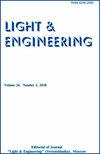从ABC模型位置看长期电流下量子阱led量子产率下降的规律
IF 0.3
4区 工程技术
Q4 ENGINEERING, ELECTRICAL & ELECTRONIC
引用次数: 1
摘要
分析了量子阱对发光二极管(led)降解的影响。提出了LED光通量与LED电流持续时间和电流密度关系的计算模型。它允许我们预测这些散热器的使用寿命与预设的电模式和温度。结果表明:-基于高带隙半导体的QW LED在长期正向电流下的量子产率降低是由于在QW区域产生了点缺陷;-点状缺陷是由于晶格点外的亚阈值位移引起的热电子与半导体原子相互作用造成的;-点状缺陷在半导体的能隙中产生了特别集中的非辐射复合中心。因此,在量子场和量子场之间的屏障中,重组流的强度向ABC模型的非辐射成分重新分布。本文章由计算机程序翻译,如有差异,请以英文原文为准。
The Regularity of the Decrease in the Quantum Yield of Quantum-Wells LEDs at the Long-Term Current Flow from the ABC Model Position
The works on degradation of light emitting diodes (LEDs) with quantum wells (QW) were analysed. The calculation model of the relation between LED luminous flux and duration of LED current flow and current density was proposed. It allows us to forecast service life of such radiators with the pre-set electric modes and temperature. It is demonstrated that:
– Reduction of quantum yield of LED with QW based on high-bandgap semiconductors with longterm flow of forward current occurs due to generation of point defects in the QW areas;
– The dot defects occur as a result of interaction between hot electrons and semiconductor atoms caused by subthreshold displacement out of the lattice dots;
– The dot defects create non-radiative recombination centres with particular concentration in the energy gap of a semiconductor, as a result of which intensities of recombination flows in QWs and in barriers between QWs redistribute towards the non-radiative component of the ABC model.
求助全文
通过发布文献求助,成功后即可免费获取论文全文。
去求助
来源期刊

Light & Engineering
ENGINEERING, ELECTRICAL & ELECTRONIC-OPTICS
CiteScore
1.00
自引率
50.00%
发文量
0
审稿时长
1 months
期刊介绍:
Our magazine
develops comprehensive communication within the lighting community, providing opportunities for discussion and free expression of opinions of specialists of different profiles;
contributes to the convergence of science and engineering practice, the search for opportunities for the application of research results in lighting and technological applications of light;
keeps the scientific community up to date with the latest advances in the theory of the light field, providing readers with operational professional information;
initiates international cooperation, promotes and distributes the results of Russian authors in the international professional community;
provides equal opportunities for authors from different regions of Russia and other countries.
The journal publishes articles in the following areas:
visual and non-visual effects of radiation on humans;
light field theory;
photometry and colorimetry;
sources of light;
ballasts;
light devices, their design and production technology;
lighting and irradiation installation;
light signaling;
methods of mathematical modeling of light devices and installations;
problems of energy saving in lighting, installation and operation of lighting installations;
modern production technologies of lighting products for lighting control systems;
innovative design solutions;
innovations in lighting and lighting design;
the study of the effect on plants and animals, problems of using light in medicine;
problems of disinfection of premises, water and smell elimination with the help of technology of UV radiation using;
problems of light in the ocean and space.
 求助内容:
求助内容: 应助结果提醒方式:
应助结果提醒方式:


